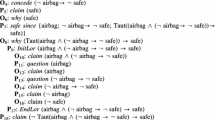Abstract
This paper presents a novel proof-theoretic account of dialogue coherence. It focuses on an abstract class of cooperative information-oriented dialogues and describes how their structure can be accounted for in terms of a multi-agent hybrid inference system that combines natural deduction with information transfer and observation. We show how certain dialogue structures arise out of the interplay between the inferential roles of logical connectives (i.e., sentence semantics), a rule for transferring information between agents, and a rule for information flow between agents and their environment. The order of explanation is opposite in direction to that adopted in game-theoretic semantics, where sentence semantics (or a notion of valid inference) is derived from winning dialogue strategies. That approach and the current one may, however, be reconcilable, since we focus on cooperative dialogue, whereas the game-theoretic tradition concentrates on adversarial dialogue.
Similar content being viewed by others
References
Barth E., Krabbe E. (1982) From axiom to dialogue: A philosophical study of logics and argumentation. Walter de Gruyter, Berlin
Barwise J., Etchemendy J. (1994) Hyperproof, CSLI lecture notes. Cambridge University Press, New York
Beun, R. (2001). On the generation of coherent dialogue: A computational approach. Pragmatics & Cognition, 9(1).
Boltzmann L. (1905) Über die Methoden der theoretischen Physik. Barth, Leipzig
Borghuis, T., & Nederpelt, R. (2000). Belief revision with explicit justifications: An exploration in type theory. CS-Report 00-17, Eindhoven University of Technology.
Brandom R. (1994) Making it explicit: Reasoning, representing, and discursive commitment. Harvard University Press, Cambridge, Mass
Bunt, H., & Girard, Y. (2005). Designing an open, multidimensional dialogue taxonomy. In C. Gardent, & B. Gaiffe (Eds.), Proceedings of the ninth workshop on the semantics and pragmatics of dialogue (DIALOR’05). Nancy, France.
Cohen P., Morgan J., Pollack M. (1990) Intentions in communication. MIT Press, Cambridge, MA
Cox, P., & Pietrzykowski, T. (1986). Causes for events: Their computation and applications. In Proc. 8th international conference on automated deduction (CADE’86) (pp. 608–621). Oxford.
Craig R., Tracy K. eds. (1983) Conversational coherence: Form, structure and strategy. Sage Publications, Beverly Hills
Evans, C., & Kakas, A. (1992). Hypothetico-deductive reasoning. In Proc. international conference on fifth generation computer systems (pp. 546–554). Tokyo.
Gentzen, G. (1934). Untersuchungen über das logische Schliessen. Mathematische Zeitschrift 39, 176–210, 405–431.
Ginzburg, J. (1996). Dynamics and the semantics of dialogue. In: Language, logic and computation (vol. 1). Stanford: CSLI.
Grice H. (1975) Logic and conversation. In: Cole P., Morgan J. (eds). Syntax and semantics 3: Speech acts. Academic Press, New York, pp. 64–75
Hamblin, C. (1970). Fallacies. Methuen & Co Ltd. [Quote from reprint by Vale Press, Newport New, Virginia, 1993].
Hamblin C. (1971) Mathematical models of dialogue. Theoria 37, 130–155
Kakas, A., Kowalski, R., & Toni, F. (1998). The role of abduction. In D. Gabbay, C. Hogger, & J. Robinson (Eds.), Logic programming, Vol. 5 of handbook of logic in artificial intelligence and logic programming (pp. 235–324). Oxford: Clarendon Press.
Levinson S. (1983) Pragmatics. Cambridge University Press, Cambridge
Lorenzen P., Lorenz K. (1978) Dialogische logik. Wissenschaftliche Buchgesellschaft, Darmstadt
Mann, B. (2002). What is dialogue coherence?. Memo available at http://www-rcf.usc.edu/billmann/WMlinguistic/dcoherence.htm.
Merritt M. (1976) On questions following questions (in service encounters). Language in Society 5(3): 315–357
Petukhova, V., & Bunt, H. (2007). A multidimensional approach to multimodal dialogue act annotation. In J. Geertzen, E. Thijsse, H. Bunt, & Schiffrin, A. (Eds.), Proceedings of the seventh international workshop on computational semantics IWCS-7 (pp. 142–153). Tilburg.
Piwek, P. (2006). The Alligator theorem prover for dependent type systems: description and proof sample. In Proceedings of the inference in computational semantics workshop (ICoS-5). Buxton, UK.
Piwek, P., & Krahmer, E. (2000). Presuppositions in context: Constructing bridges. In P. Bonzon, M. Cavalcanti, & R. Nossum (Eds.), Formal aspects of context, Vol. 20 of applied logic series (pp. 85–106). Dordrecht: Kluwer Academic Publishers.
Piwek, P., & van Deemter, K. (2002). Towards automated generation of scripted dialogue: Some time-honoured strategies. In EDILOG 2002: Proceedings of the sixth workshop on the semantics and pragmatics of dialogue (pp. 141–148).
Power R. (1979) The organisation of purposeful dialogues. Linguistics 17, 107–152
Pulman, S. (1999). Relating dialogue games to information states. In Proceedings of the European speech communication association workshop on dialogue and prosody (pp. 17–24). The Netherlands: De Koningshof.
Saarinen E., eds. (1979) Game-theoretical semantics. D. Reidel, Dordrecht
Schegloff, E. (1972). Sequencing in conversational openings. In Directions in sociolinguistics (pp. 346–380). New York: Holt, Rinehart & Winston.
Schegloff E., Sacks H. (1973) Opening up closings. Semiotica 7(4): 289–327
Schroeder-Heister P. (2006) Validity concepts in proof-theoretics semantics. Synthese 148, 525–571
Stenius E. (1967). Mood and language-game. Synthese 17: 254–274
Stenström A.-B. (1994) An introduction to spoken interaction. Longman, London and New York
Sudnow D., eds. (1972) Studies in social interaction. The Free Press, New York
Sundholm, G. (1986). Proof theory and meaning. In Handbook of philosophical logic (Vol. III, pp. 471–506). D. Reidel.
Taylor J.A., Carletta J., Mellish C. (1996) Requirements for belief models in cooperative dialogue. User modeling and user-adapted interaction 6(1): 23–68
Traum, D., & Larsson, S. (2003). The information state approach to dialogue management. In Current and new directions in discourse and dialogue (pp. 325–353). Kluwer Academic Publishers.
Waismann, F. (1965). The principles of linguistic philosophy. Macmillan.
Walton D., Krabbe E. (1995) Commitment in dialogue: Basic concepts of interpersonal reasoning. SUNY Press, New York
Wittgenstein L. (1984) Philosophische grammatik. Suhrkamp, Frankfurt a.M.
Author information
Authors and Affiliations
Corresponding author
Additional information
An erratum to this article can be found at http://dx.doi.org/10.1007/s10849-008-9069-2
Rights and permissions
About this article
Cite this article
Piwek, P. Meaning and Dialogue Coherence: A Proof-theoretic Investigation. J of Log Lang and Inf 16, 403–421 (2007). https://doi.org/10.1007/s10849-007-9046-1
Received:
Accepted:
Published:
Issue Date:
DOI: https://doi.org/10.1007/s10849-007-9046-1




